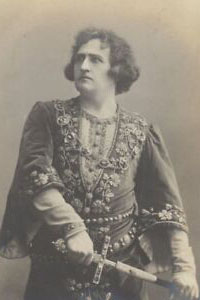The History of Wilhelm Grüning

Born: 2 Nov 1858 Berlin
Died: 2 Dec 1942
German tenor.
This concludes the tenors, selected for our survey who were born in the 19th century.
Before carrying on with those born in the 20th century however, I should like to draw attention to many other fine tenors, born in the last century, who were, though not internationally famous, nonetheless spent noteworthy careers on the operatic stage.
Not everyone had a voice like Caruso or Gigli, the technique of DeLucia or Yadlowker, or the charisma of McCormick or Schipa.
The other tenors simply gave the best they had to offer. Many were content to be in demand in their country of origin, and to shine in the opera houses of their native cities, without perhaps appearing often in the great opera houses of the world where the Bonaci’s, Zena Tello’s and Martinelli’s were to be found.
Many did not relish traveling the long and sometimes hazardous distances necessary for an international career.
We know from our survey, how popular opera was before the days of popular music, radio and television. And somehow the myriad number of opera houses throughout Europe and the Americas, had to find the singers for their productions.
It was this situation, that gave livelihoods to hundreds of singers, who knew very well, that they could hardly hope to compete with the great stars of the operated firmament.
Many of these singers, were good enough however, to be asked to make gramophone records. Sometimes, as stars for the smaller companies, sometimes for the major companies, who would issue them on their cheaper non-celebrity labels.
Often too, the major companies would recognize the popularity of a singer in his or hers own country, and would supply a long list of records, of popular arias and songs, sung in the singer’s native language.
These records which sell well in the singer’s country of origin, but might rarely be issued anywhere else.
So, for the rest of this tape, and the whole of the next, we are going to hear samples of these tenors, and where possible, I shall include brief biographical details, just to put them in perspective.
The list is not meant to be comprehensive, but rather a reminder that we’re only hearing a few of the hundreds of tenors that made their living from the opera, during its heyday.
Before we start, I must again thank Eddie Findley, for his considerable help in this particular section. Both for supplying so many examples and for selecting some of the discs that we are about to hear.
To begin with, I should like to briefly mention the names of four famous tenors, who did make records. Great rarities, in their original 78 form, but who are not represented in our collections.
Herman Winkelman 1849 to 1912 was Slezak’s great predecessor, at the Vienna Opera. The creator of Wagner’s last opera, Pacival, and also of Rubenstein’s opera, Nero. This famous tenor was for 25 years undisputed principal tenor at Vienna. He made 6 G&Ts in 1905, four favourites in 1906 and there are known to be two Berliners of 1902.
Francesco Marconi 1853 to 1916 was a famous Italian tenor, who appeared at Covent Garden in the early 80’s. He was the Arturo in Puritani, on Battistini’s London debut for example. He was 55 when he came to make his records and although no longer young, the voice is still in reasonable condition.
The main interest in his records, is that they show how much more slowly and more freely the music used to be taken, a touch of the Vannice style in fact.
Ernest Van Dyck 1861 to 1923 was a celebrated Belgium tenor and rival of Jean Deresce. A superb Wagnerian, he was also able to sing such roles as Romeo, Faust and Degreaux. He created Verta in 1892 and there, evangelic man at the world premiere, in Vienna.
Unfortunately, he used the Sprechtgesang method of voice production, through which, one got an explosive tone and an early retirement.
Both Schmede’s and Vin Roy who used the same method, were vocally finished at 40, like Van Dijk.
About a dozen records are known to exist, 3 Pathe’s of 1903 and 8 French Phonotapayas of 1905, plus a single homophone.
And finally, another important Italian tenor was Eduardo Garbin, who made a few records for G&T in 1903 and began a series for Phonotapaya in 1904. I have traced 42 items from my phonotapaya catalogue. He did not record well. The voice sounding persistently white.
No LP of his records has ever been issued, to my knowledge.
In chronological order then, we begin with Wilhelm Gruning 1858 to 1942.
An important German tenor, who after his debut in Danzig in 1881, quickly rose to become a leading tenor at Berlin and Bayreuth for over 20 years.
He also appeared in England, Holland, and America.
His records are scarce, although he did record for the gramophone company, Odeon, and Colombia.
This extract is from Wagner’s Lohengrin.
Extract / Lohengrin / 1900 – Wilhelm Grüning

The History as it was Recorded
Sydney Rhys Barker
